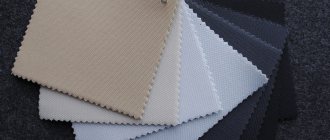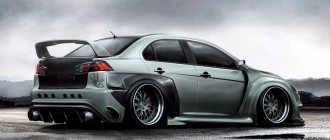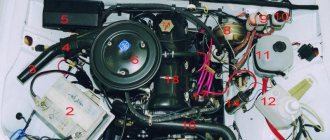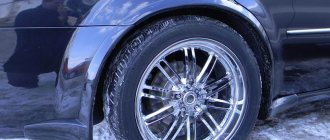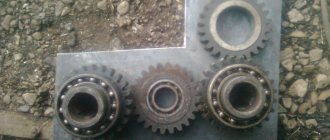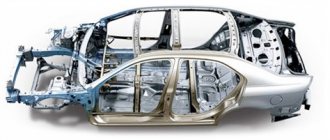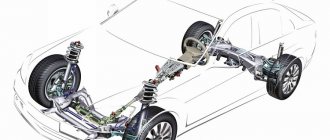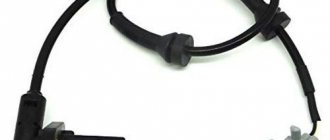What is a car frame: purpose, pros and cons
The car frame is a beam structure that acts as the basis for fastening all components and assemblies, such as the power plant, transmission elements, chassis, and so on. The body with this design of the supporting system provides space to accommodate passengers and luggage, and also performs a decorative function.
Car frame
The use of a frame makes it possible to give the load-bearing part high strength. That's why it is used in trucks and SUVs. It also makes it possible to maximize the unification of components and mechanisms between models of different classes.
Previously, car manufacturers produced car chassis with basic parts (frame, engine, transmission, etc.), onto which various types of bodies were “stretched.”
The frame in the car acts as a “skeleton”. It absorbs all external and internal loads when the car is moving and even when it is parked. In view of this, a number of requirements are imposed on the automobile frame:
- sufficient strength and rigidity;
- small weight;
- the correct shape, which will contribute to the rational operation of all elements of the car.
The frame bearing part has a number of advantages. So, thanks to it, assembling the car and repairing it in the future becomes much easier. The main difference between a frame structure and a body structure is that any breakdown can be easily repaired thanks to a good specialist and materials. Another important advantage: driving on bad roads will not be fraught with distortions of the body (door openings, pillars, etc.).
Spar frame
Along with this, there are also disadvantages. The first is a significant increase in the weight of the car due to the presence of a separate frame and body. Accordingly, fuel consumption will also be higher. Another disadvantage is that placing the side members under the body requires additional space, which makes getting into the car difficult and takes up a significant part of the interior.
There is also a decrease in passive safety, since there is a possibility of the frame shifting relative to the body in the event of an impact. Therefore, the load-bearing body is an integral element of a passenger car. At the same time, the frame design copes well with the harsh conditions in which trucks and SUVs drive.
Vehicle support system: frame, body
The supporting system serves as a kind of car frame. Thanks to a reliable load-bearing base, the most important parts of the body, engine, suspension and transmission elements are attached to form an integral structure. Historically, all vehicles were designed on a “frame”. However, with the advent of the monocoque body, the frame in passenger cars was forgotten. Currently, the auto supporting system is used mainly in the construction of limousines, SUVs, tractors and trucks.
The frame principle of connecting the main systems was borrowed by the creators of the first machines from the designers of railway transport. In the automotive industry, the supporting system is called the chassis. In fact, such a frame chassis can be used autonomously, without any body.
The materials used for the first frames were valuable wood species, as well as metal in the form of round pipes. Serial models of frames made of stamped profiles with a rectangular cross-section appeared at the beginning of the 20th century. However, after only 30 years, frame cars were replaced by “passenger cars” with a self-supporting body.
What types of frame structures are there?
A traditional car frame consists of beams, to which the main automotive systems are attached using fasteners, including power units and chassis elements (axles, suspension, wheels with rims and tires). The car body, as part of the load-bearing part, serves as a place to accommodate passengers and cargo, and also performs a decorative function.
Any frame structure involves a functional separation of the load-bearing elements of the body and decorative parts, sometimes reinforced with a special frame. The durable frame can be fixed next to doorways. This option does not involve support during the process of power loads that are inevitable when operating a car. Depending on the type of body support used, all frames are divided into:
- spar;
- spinal;
- peripheral;
- fork-spine;
- lattice frames;
- load-bearing elements built into the body.
There are also combined types of automobile frames, consisting of elements of various designs.
Advantages and disadvantages
An important advantage of the frame structure is the high strength of the load-bearing vehicle body. For this reason, the frame is ideal for trucks and SUVs, even though the overall weight of a vehicle with a frame carrier is noticeably higher.
Another positive quality of the frame is the universal nature of its use. In the production of standardized components and assemblies compatible with the chassis, it is possible to produce various car models that differ only in the appearance of the body and interior design. Some automakers use this “cunning” principle when creating restyled modifications in order to save money. It is noteworthy that the assembly of cars with a frame base is simpler, and repairs are usually less labor-intensive.
And yet the monocoque body is much more popular today. This is due to significant disadvantages of frame machines, including:
- large vehicle weight due to the separation of the purposes of the frame and body;
- massive side members located under the car body. Their volume is compensated by the space for passengers, while the impressive height of the thresholds makes getting into the car less comfortable;
- low level of passive safety due to possible displacement of the frame structure relative to the body in an accident;
- lower torsional rigidity compared to the characteristics of the monocoque body.
In an effort to make a passenger car meet modern safety and comfort requirements, automakers replaced the frame structure with a monocoque body. But it is still impossible to do without a frame car in off-road conditions, increased vibration while driving, as well as excessive load on the chassis.
Features of different types of frames
Spinal frame
The development of the Czech company Tatra was first used in the production of cars from this company. A frame with a frame in the form of a pipe connecting transmission parts and the power unit has proven itself well and has become widespread among other automakers.
Structurally, the backbone frame is a single unit with the engine, clutch and gearbox, because each of the system elements is securely connected to the frame structure with a rigid fastening. The shaft inside the frame tube, through rotation, carries out torque from the motor to the components of the transmission. The specificity of the mechanism is the mandatory independent suspension for all wheels.
The backbone frame attracts motorists with its high torsional rigidity. The use of spindle technology allows you to quickly and efficiently create models with multiple drive axles without losing the quality and safety of vehicle control. But the maintenance and repair of parts can be difficult, because some of the mechanisms are difficult to access, since they are located inside the frame structure.
Fork-spine frames
A variation of the spinal frame was also invented by the Tatra engineering team. The fork-spine structure is equipped with a kind of forks for the motor and transmission, installed on both sides of the main carrier pipe. The tridents crowning the frame at the front and rear serve as brackets, the point of connection with the side members, to which suspension parts and other components are attached.
The uniqueness of this type of frame lies in the use of a conventional driveshaft and the absence of a rigid coupling between the frame, axles and engine. Unfortunately, placing the power unit at the rear of the car led to problems with handling, so fork-spine systems are practically not used in the design of modern vehicles.
Peripheral frames
A special type of spar frames became known in Europe in the sixties of the last century, when the peripheral structure began to be used in the production of large passenger cars and “dreadnoughts” from the USA. The spars in frames of this type are located at the thresholds at a large width from each other so that the high floor of the car is larger in area than in a standard body. At the same time, the height of the machine with a peripheral frame is significantly less. The relatively low strength of the frame cross member due to its special location forced engineers to provide a more reliable and rigid body for the car that can withstand even powerful side impacts.
Spatial frames
One of the most complex types of frame construction is used to create sports cars. Thin alloy metal pipes are torsion resistant but still bendable. In the modern automotive industry, monocoques have gained confidence, representing a spatial structure, the outer shell of which serves as the main load-bearing element.
Regardless of what type of supporting system your car has, the “foundation” of the vehicle requires maximum care and attention.
Specialists from the official service centers of the FAVORIT MOTORS Group of Companies carry out computer diagnostics of the condition of the chassis, the most important components and assemblies of the car. Experienced technicians provide competent maintenance, promptly identify and eliminate any malfunctions. All work is completed on time and at affordable prices. Contact the professionals! Sign up for the service Ask a question
Spar frame
This is the most common type. The frame design includes two power longitudinal beams, which are called spars. They stretch along the body and are connected by crossbars. The beams are made of steel. In order to increase twisting performance, various types of section profiles can be used.
The spars are not necessarily straight - sometimes they have both vertical and horizontal bends. They can be located either parallel to the horizontal plane or at a certain angle, which is typical for SUVs. It is also possible to have different arrangements of the cross members, through which the spars are connected. Today it is the most popular frame design, used in most trucks and SUVs.
This frame is perfect for operating the car on bad roads. It also simplifies the repair and assembly of the car. The disadvantages are that the spars take up a considerable part of the interior and somewhat complicate the landing process.
Types of spar frames
Spar X-shaped
An X-shaped frame is one of the types of spar frames. The peculiarity of its design is that the spars at the front and rear are spread apart, and in the center they are brought together as much as possible. This type is similar in appearance to the “X” beech, which is the reason for its name.
Peripheral
It is a type of spar frames. This type began to be actively used on large European-made passenger cars and “dreadnoughts” from the USA in the 60s. In such frames, the spars are located so widely that during the installation of the body they are located at the sills. This allows the floor level to be significantly lowered, while at the same time reducing the immediate height of the machine.
An important advantage of such a machine is its maximum adaptability to side impacts. However, there is a significant drawback - the frame cannot withstand significant loads, so the car body must have the necessary strength and rigidity.
What are the disadvantages of frame construction?
It should be noted that today passenger cars have a monocoque body design, and frame systems are practically no longer used. Despite the simplicity of the supporting frame and ease of repair, it has a number of disadvantages:
- the supporting frame significantly increases the weight of the car and its external dimensions;
- increased consumption of fuel consumed and the emission of large amounts of exhaust gases;
- inability to achieve high speed indicators (passenger cars);
- reduced level of comfort when using hard springs;
- the need for increased clearance. High thresholds can make it difficult for the driver and passengers to get into the car.
Despite the above disadvantages, the frame design is actively used for the production of trucks and SUVs, for moving large loads and overcoming difficult road sections. In addition, driving trucks and all-terrain vehicles has a high level of safety.
Spinal frame
This type of frame was developed by representatives and was mainly used for machines produced by it. The main supporting element is a pipe connecting the engine at the front with the transmission elements that are located inside it. Essentially, the pipe acts as a single housing for the gearbox, transfer case and drive shafts. Torque from the engine to the transmission is supplied through a shaft placed in the pipe. Moreover, this shaft is not a cardan shaft, which ensures greater reliability.
Spinal frame
This frame design, combined with independent wheel suspension, provides very long travel, which makes it indispensable in special-purpose vehicles.
The advantage of the backbone frame is also that it has very high torsional rigidity, and the transmission elements are reliably protected from external influences. But due to the fact that certain mechanisms are located inside the frame structure, repair work becomes noticeably more complicated.
Fork-ridge
The fork-spine type of frames is also a Tatra development. In this version, the engine is not mounted to the transmission pipe, but on a special spar fork. This is done in order to reduce the level of transmitted vibrations from the operating internal combustion engine to the frame and, consequently, to the car body. However, today fork-spine frames are no longer used in the automotive industry.
Fork-spine frame
1.1. Truck frame
A frame is most often used as the supporting structure of a truck system (Fig. 105).
There are spar and spinal frames. The spar frame consists of two longitudinal stamped cans of channel cross-section - spars, interconnected by several cross members. This frame is called a spar frame. Cross members are usually stamped and serve not only to connect the side members together and give the entire structure the necessary rigidity, but also to fasten various components of the car. Low carbon steel is usually used to make frame elements. The connection of spars and cross members is most often done using rivets. In the necessary places, various brackets and other parts for installing vehicle components are attached to the side members and cross members, also with rivets or bolts.
Rice. 105. KamAZ-5320 vehicle frame: 1 — front buffer mounting bracket; 2 - first cross member; 3 — right spar; 4 — front engine mount bracket; 5 — front axle spar extension insert; 6 - two halves of the second cross member; 7 — rear engine mount bracket; 8 — bracket for fastening the supporting support of the power unit; 9 — two halves of the third cross member; 10 - fourth cross member; 11 — extension insert of the intermediate bridge spar; 12 — two halves of the fifth cross member with reinforcing gussets; 13 — extension insert of the rear axle spar; 14 - sixth cross member; 15 — rear cross member brace; 16 — reinforcing rear cross member; 17 — rear cross member; 18 — brace gusset; 19 — rear cross member brace brace; 20 — left spar; 21 — rear bracket of the front suspension; 22 — bracket for fastening the upper ear of the shock absorber; 23 — water radiator mounting bracket; 24 — front suspension bracket
Welding in the manufacture of frames is used quite rarely, since the side frames of trucks are relatively flexible to bending, and especially torsion, and welds under these conditions are a source of crack formation.
The ability of the frame to deform under torsional loads avoids unnecessarily high stresses at the joints.
The truck cabin is fixed to the frame at three or four points using elastic devices, and deformations of the frame when the vehicle moves on an uneven road do not cause corresponding deformations of the cabin.
In rare cases, trucks use a so-called backbone frame, which is a large-diameter steel pipe running along the vehicle along its longitudinal axis. In the front part, the frame bifurcates, forming two longitudinal spars that serve to install the engine and gearbox. A cardan transmission is located inside the pipe. In this case, the driving axles of the car have sprung gearboxes, from which torque is supplied to the wheels by swinging axle shafts.
Source
Space frame
The most complex type of frame structure used for sports cars. This design is a frame based on thin alloy pipes and has very high rigidity and strength. In the automotive industry, these frames were supplanted by monocoques, however, similar designs are used to create buses.
Space frame
Advantages and disadvantages
In modern passenger cars, preference is given to a monocoque body. This happens for a number of reasons. Despite the obvious advantages (simple design, simplified vehicle assembly at the factory, easy repairs), the frame body also has significant disadvantages. Firstly, when separating the functions of the body and frame, the mass has to be significantly increased. Secondly, the side members that run under the body take up a significant portion of the passenger compartment. The thresholds are large, and this makes it difficult to get into the car. Thirdly, frame cars have a significantly lower level of passive safety, due to the possibility of the frame shifting relative to the body upon impact. Fourthly, a flat frame is inferior to a monocoque body in terms of torsional rigidity.
Load-bearing base
The load-bearing base is something between a body and a frame structure. Spars are also used here, but they are united by a bottom rather than cross members. The most widespread and popular owner of a load-bearing bottom is the Volkswagen Beetle, in which the body is attached to a flat floor panel using bolts. Another mass-produced car, the Renault 4CV, has a similar design.
Load-bearing base
The load-bearing bottom is highly technological and is used in large-scale production. This design makes it possible to make the floor and center of gravity of the car quite low.
The frame load-bearing part of the car has a number of advantages and features that make it indispensable for trucks and SUVs. And although the frame is used purely for specific types of cars, some elements of its design are used extremely widely, as they make it possible to make the load-bearing bodies more rigid. Almost every passenger car is equipped with reinforcing side members or subframes.
Purpose, types
The car frame is a beam structure that acts as a basis for fastening all the components of the car - the power plant, transmission units, chassis, and so on. The body, present in the design of the supporting part, performs only some functions - it provides space to accommodate passengers and cargo, and also acts as a decorative element.
The main positive quality of using a frame is the high strength of the load-bearing part. This is why it is used on trucks and full-fledged SUVs. But at the same time, due to the frame, the total weight of the car is increased.
Also, the car frame allows for maximum unification of components and mechanisms between models of different classes. At one time, it got to the point that many automakers produced a car chassis with all the main parts (frame, engine, transmission, chassis), on which they “stretched” different types of bodies.
At the same time, several types of frames were developed, each of which has its own design features. All of them can be divided into:
Some of these types have subtypes, and combined types are also often used, the design of which contains components of different frames.
Spar and its subtypes
The spar car frame is the most common. Its design includes two longitudinal power beams - spars, stretching along the entire body and interconnected by cross members.
Toyota Land Cruiser spar frame
The spars themselves are made of steel, and to ensure high torsion performance, different types of section profiles are used - box, I-beam, channel.
Moreover, it is not necessary that they be even; many spars have bends in both vertical and horizontal planes. For example, on some cars the frame is curved in the front and rear parts (in the area where the wheels are located), which allows you to move the center of gravity down.
In addition, the spars are placed either in a strictly horizontal position relative to the floor or can be at an angle. The second option is used on SUVs.
The spars are connected by cross members, which can be arranged in different ways. In the so-called ladder-type frame, the cross members are attached perpendicular to the side members (considered classic). But there are also structures in which these components are located at angles - K-shaped and X-shaped frames.
Spar x-frame
To connect the side members to the cross members, welding (in SUVs) and rivets (trucks) are used. In some cases, bolted connections are used. To fasten vehicle components, both side members and cross members are equipped with brackets.
A subtype of the spar frame is the peripheral one. Its distinctive feature is the large distance between the side members. After the car is fully assembled, they are located near the body sills, which significantly increases resistance to side impacts, and also allows you to lower the floor level (as much as possible).
Corvette peripheral frame
Another type of spar frame is X-shaped. The essence of the design of such a frame comes down to the fact that in the front and rear parts the side members are separated, and in the central part they are brought together to the maximum (the space between them allows only the transmission shafts to be placed). Externally, this type resembles the letter “X”, hence the name.
Another option is a load-bearing base. The design of this frame still uses longitudinal spars, but here they are connected to each other not by cross members, but by a bottom. At the same time, the load-bearing base, although the bottom is included in it, is not an element of the body, which is why this type is classified as a frame.
Spinal frame
Backbone-type frames are less common and, in fact, they are used only on Tatra trucks. The main component of this type of load-bearing part is a central beam made of pipe.
BoGdIcH › Blog › Let's talk about car frames.
The car frame is the supporting system of the car, which is a “skeleton” onto which the body, engine, transmission units, and suspension are attached. The resulting structure is called a chassis. In most cases, the frame chassis can even be moved on the road separately from the car body. Let's take a closer look at the types of frames:
1. Spar frames.
They include several cross members, which are sometimes called “traverses”, a pair of longitudinal spars (this is the name given to the main strength element of the supporting structure, which is a complex-shaped box made of metal), brackets and fastenings designed for installing a car body and various units. Both cross members and side members may differ in design and shape. There are X-shaped, K-shaped, and tubular cross members. Their purpose is to give the structure the maximum possible rigidity.
For the manufacture of traverses, a bent metal profile is usually used. The most characteristic feature of spars is a U-shaped section (channel) that varies in length. In the most loaded areas, the height of the channel section is increased.
The spars can be located parallel to each other or at a certain angle. In addition, the spars can be installed curved in a vertical or horizontal plane. The parallel arrangement is used primarily on commercial vehicles. The remaining schemes are well suited for SUVs.
By installing the side members at an angle, you can achieve the maximum angle at which the car's steered wheels turn. Bends in the vertical plane are made to reduce the center of gravity. At the same time, the floor level in the car also becomes lower. Thanks to the bending of the side members in the horizontal plane, in addition to lowering the floor level, a significant increase in the level of passive safety is achieved in the event of a possible lateral collision.
To connect the parts that make up the frame, bolts and rivets are used. Welded joints are also widespread. Riveted frames are more often used in the construction of trucks, and welded frames are used in the manufacture of passenger cars and dump trucks with heavy loads. Bolts have found application in small-scale production. Almost all trucks and SUVs are equipped with spar frames. The popularity of such structures is due to the fact that the concept of “frame” most often means just a spar supporting system.
The development of the spinal frame was carried out by Czechoslovakia in the 20s of the last century. Many cars produced by this company were then equipped with such frame chassis. The main structural element of the spinal frame is the central transmission pipe, on which the crankcases of the power unit and such components as the clutch, gearbox, and main gear are combined. The installation of such a frame is accompanied by the need to equip the car with an independent suspension of all wheels, which in most cases is realized by attaching a pair of swing axle axles to the sides of the ridge (each of them has one hinge). The main advantage of this scheme is the high torsional rigidity. In addition, it becomes possible to seamlessly develop various modifications of cars with different numbers of drive axles. The main disadvantage is the difficulty of repairing units that are rigidly fixed to the frame. This is the reason for the low popularity of backbone frames in the modern automotive industry.
